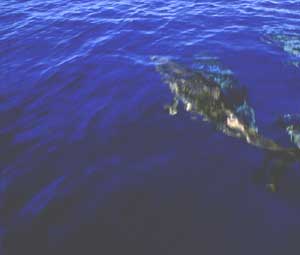Protecting the environment: Tubbataha Reef
Importance of the Reefs:
 The Tubbataha reef system is located at the center of Sulu Sea, about halfway between Palawan and Panay islands. It covers 32,200 hectares full of diverse coral reefs, fish and other marine life, and various birds and invertebrates. Such diversity is provided by the presence of over 300 coral species, 46 coral genera, 71 species of algae, seven species of seagrass. It is one of the world's largest grouping of varieties of marine life. It is part of the Sulu-Celebes Global 2000 Marine Ecosystem. Large marine life are present, such as sharks, manta rays, dolphins, marine turtles. Several species of seabirds breed in the area. Significantly, important fish and invertebrate larvae originate from the reef system. The continuous destruction of these larvae seriously threatens the marine food supply of the entire Sulu Sea area.
The Tubbataha reef system is located at the center of Sulu Sea, about halfway between Palawan and Panay islands. It covers 32,200 hectares full of diverse coral reefs, fish and other marine life, and various birds and invertebrates. Such diversity is provided by the presence of over 300 coral species, 46 coral genera, 71 species of algae, seven species of seagrass. It is one of the world's largest grouping of varieties of marine life. It is part of the Sulu-Celebes Global 2000 Marine Ecosystem. Large marine life are present, such as sharks, manta rays, dolphins, marine turtles. Several species of seabirds breed in the area. Significantly, important fish and invertebrate larvae originate from the reef system. The continuous destruction of these larvae seriously threatens the marine food supply of the entire Sulu Sea area.
Present Problems:
Marine resources in the area are fast being depleted, as indicated by various surveys made in 1988, 1989, 1992 and 1995. The quantity of fish and coral are decreasing alarmingly. Destructive fishing methods - dynamite and cyanide fishing, in particular - continue.
The situation is worsened by widespread opportunism and carelessness of the people. These are shown by practice of killing marine turtles, the illegal gathering of turtle eggs, bird eggs and shells, and by irresponsible tourists and businessmen.
People do not live permanently in Tubbataha. However, many fishermen camp among the reefs and tiny islands between January and July to fish and exploit the marine resources.
Reef Management Efforts:
Several significant measures and efforts have been made in recent years to save and control the environment of Tubbataha Reef. Among these are:
- Proclamation by President Corazon Aquino in 1988 declaring Tubbataha as the First National Marine Park. The proclamation called upon the Department of Environment and Natural Resources (DENR) and other concerned government agencies to save the marine park.
- Internationally, in 1993, the United Nations Educational, Scientific and Cultural Organization (UNESCO) declared the Tubbataha as a World Heritage Site. The UNESCO declaration provided international support to protect the reef.
- In addition, in 1995, President Fidel Ramos created the Task Force for Tubbataha Reef National Marine Park. This Task Force included the DENR, Palawan provincial government, police and military authorities and representatives of non-government organizations (NGOs).
UNESCO Role:
This UN agency has played a very vital role in efforts to save the reef. Through the World Heritage Fund, the UNESCO provided funds in 1996 for monitoring activities and to conduct an information and education campaign. These activities were supervised by a team composed of representatives from the Presidential Task Force for Tubbataha Reef, the DENR, National Committee on Marine Science, and the Palawan Council for Sustainable Development.
Other Efforts:
Meanwhile, other efforts by the government are being made, together with foreign and private organizations. Highlights of these efforts to save the reefs are:
- More sea patrols on the area, with support from the Dutch government, the Foundation for Philippine Environment, and the Tubbataha Foundation. These are coordinated by the DENR.
- The Foundation for Philippine Environment, EarthWatch, Inc., Silliman University and other individual researchers and scientists also undertake research and monitoring of the reef
- Preparation of the Tubbataha Reef National Marine Park Management Plan. This is assisted by the Japanese government. Japan also helped in the construction and installation anchorages for diving boats in the reef
- Research and monitoring project started in 1995 by the Kabang Balikasan ng Pilipinas and World Wildlife Fund. The objective is to get data and other information needed to develop management plan for the reef. This is funded by WWF-United States, the Ayala Foundation, the A. Soriano Jr. Foundation and other private individuals.
The Future of Tubbataha:
After many years of neglect, there are now greater and more widespread efforts to save Tubbataha reef. And yet, it seems that all these efforts are not well-coordinated. In fact, some of the efforts quickly die out. Many are handicapped by lack of funds, and even government support is not enough.
The public is now more aware of the reef and its importance to the environment and the economy. Somehow, it is also possible that greater public awareness can do some harm, because more people might over-use the reef. Without sufficient safeguards and supervision, the reef system would be damaged by the bad effects of too much recreation, tourism and economic activities.
There is therefore a very great need for an effective organization and planning to save the reef. Such should also take care of the people and communities that depend on the reef. The management of the reef need to be funded adequately, with support of the government, the private sector and the people.